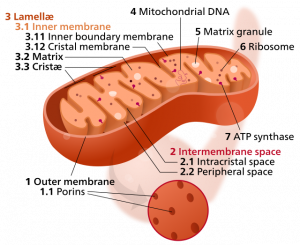Aging. Getting up in years. Striving to live as long as possible and to be as strong and healthy as possible. At some point, good health becomes a more important concern than wealth. Optimal selenium status is important to good health [Alehagen 2021].

In a review article, Professor Urban Alehagen and Professor Jan Aaseth list the following conditions associated with biological aging [Alehagen 2021]:
- chronic mild to moderate systemic inflammation
- detrimental DNA alterations
- mitochondrial dysfunction
- oxidative stress caused by harmful free radicals
- telomere shortening
Getting old is inevitable. Biological aging necessarily involves a weakening of the immune system and increased susceptibility to diseases and environmental stresses.
Selenium deficiency associated with aging and aging-related diseases
Selenium deficiency is associated with mitochondrial dysfunction, oxidative stress, and inflammation [Alehagen 2021].
Mitochondrial injuries are an important factor in the aging of human cells. A by-product of the mitochondrial generation of ATP energy in the cells is the production of reactive oxygen species, some of which are useful and some of which are harmful. The leakage of these harmful free radicals from the mitochondrial respiratory chain increases with age, which results in cellular oxidative damage, whenever there are not enough antioxidants to neutralize the effects of the free radicals.

Mitochondrial dysfunction, oxidative stress, chronic systemic inflammation, and biological aging interact with one another in complex ways. Oxidative stress and chronic inflammation in the elderly individuals represent risk factors for cancer, cardiovascular disease, and neurodegenerative disorders [Alehagen 2021].
Studies have shown that low intakes of selenium appear to increase vulnerability to different diseases and to decrease human life expectancy. In this respect, blood selenium concentrations function as a longevity index in elderly individuals [Alehagen 2021].
Selenium Status and Risk of Cancer
A 2020 meta-analysis of the pooled data from 37 studies showed that selenium intakes at daily levels of greater than 55 mcg were associated with a decreased the risk of cancer. Moreover, extra selenium intake from supplements was protective at levels equal to or greater than 55 mcg/day. The meta-analysis showed an inverse relationship between selenium intake and overall cancer risk after adjusting for age, body mass index, and smoking. These findings suggest that selenium is protective against cancer; however, the protective effects vary with different cancers [Kuria 2020].
The available scientific evidence seems to show that sub-optimal intakes of selenium are associated with an increased risk of certain cancers in elderly people, possibly because low selenium intakes result in less protection against oxidative stress and inflammation. Additional protection against cancer by means of selenium supplementation is not expected in individuals with an adequate plasma selenium status, i.e., plasma levels that are clearly above
1.0–1.2 micromol/L (above 80-95 mcg/L) [Alehagen 2021].
Note: Professor Margaret P. Rayman, University of Surrey, UK, estimates that the optimal serum/plasma selenium concentration for good health and protection against disease is around 125 mcg/L [Winther 2020].
Selenium Status and Cardiovascular Disease Risk
In the BIOSTAT-CHF cohort study, patients with worsening heart failure who were deficient in selenium (plasma concentrations below 70 mcg/L) had more severe signs of heart failure and lower quality of life than heart failure patients with higher serum selenium concentrations. In the study, heart failure patients with serum selenium concentrations of 70–100 mcg/L appeared to have similar adverse associations, suggesting that serum selenium values below 100 mcg/L might be considered abnormal [Bomer 2020].
In the Malmö Preventive Project cohort study in which 4366 individuals were followed for 9.3 years on average, plasma selenoprotein P concentrations were inversely associated with the risk of all-cause mortality, cardiovascular mortality, and a first cardiovascular event. Selenoprotein P is the primary transporter of selenium from the liver to the other organs [Schomburg 2019].
A 2021 meta-analysis of the data from 13 studies showed that there was a reduced risk of cardiovascular incidence and mortality in individuals with higher selenium status compared to individuals with lower selenium status. There was a 15% decreased risk of cardiovascular incidence per 10 mcg increased increment in blood selenium concentration [Kuria 2021].
Selenium Status and Alzheimer’s Disease
Aging is a significant risk factor for developing a neurodegenerative disorder. Mitochondrial dysfunction and oxidative stress represent one proposed link between ageing and neurodegenerative disorders [Alehagen 2021].
Selenoproteins are known to defend against oxidative stress; thus, selenium deficiency may increase elderly individuals’ vulnerability to these disorders. In fact, elevated levels of reactive oxygen species appear to play a role in the
pathologies of Alzheimer’s disease and Parkinson’s disease. Antioxidant selenoenzymes may fulfill protective functions [Alehagen 2021].
In a 2017 meta-analysis of 12 case-control/observational studies reporting selenium concentrations in Alzheimer’s disease patients and healthy controls, researchers observed that circulating selenium concentrations were significantly lower in the Alzheimer’s disease patients compared to controls and that this lower selenium status was directly correlated with an important antioxidant enzyme in Alzheimer’s disease, glutathione peroxidase [Reddy 2017].
In a 2022 meta-analysis of six studies, researchers found that selenium supplementation was associated with an improvement in selenium levels, glutathione peroxidase activity, and cognitive test scores in patients with mild cognitive impairment and with improvement in selenium levels and mini-mental scores in Alzheimer’s disease patients [Pereira 2022].
Conclusion: Selenium Supplementation and Resistance to Disease
As we get older, we become more vulnerable to the adverse effects of environmental stresses and to disease pathology.
Studies show that selenium deficiency is closely associated with biological aging and with aging associated diseases [Alehagen 2021].
Dietary and supplemental selenium are important nutritional agents in the protection against age-related diseases through a strengthening of the immune response [Alehagen 2021].
Maintaining a serum selenium concentration of ca. 125 mcg/L is the recommendation of selenium scientists [Winther 2020].
Taking a selenium yeast supplement, which contains numerous different species of selenium, seems the best choice [Richie 2014].
Sources
Alehagen U, Opstad TB, Alexander J, Larsson A, Aaseth J. Impact of Selenium on Biomarkers and Clinical Aspects Related to Ageing. A Review. Biomolecules. 2021; 11(10):1478.
Bomer N, Grote Beverborg N, Hoes MF, Streng KW, Vermeer M, Dokter MM, IJmker J, Anker SD, Cleland JGF, Hillege HL, Lang CC, Ng LL, Samani NJ, Tromp J, van Veldhuisen DJ, Touw DJ, Voors AA, van der Meer P. Selenium and outcome in heart failure. Eur J Heart Fail. 2020 Aug;22(8):1415-1423.
Hariharan S, Dharmaraj S. Selenium and selenoproteins: Its role in regulation of inflammation. Inflammopharmacology. 2020;28:667–695.
Kuria A, Tian H, Li M, Wang Y, Aaseth JO, Zang J, Cao Y. Selenium status in the body and cardiovascular disease: a systematic review and meta-analysis. Crit Rev Food Sci Nutr. 2021;61(21):3616-3625.
Kuria A, Fang X, Li M, Han H, He J, Aaseth JO, Cao Y. Does dietary intake of selenium protect against cancer? A systematic review and meta-analysis of population-based prospective studies. Crit Rev Food Sci Nutr. 2020;60(4):684-694.
Pereira ME, Souza JV, Galiciolli MEA, Sare F, Vieira GS, Kruk IL, Oliveira CS. Effects of selenium supplementation in patients with mild cognitive impairment or alzheimer’s disease: a systematic review and meta-analysis. Nutrients. 2022 Aug 5;14(15):3205.
Reddy VS, Bukke S, Dutt N, Rana P, Pandey AK. A systematic review and meta-analysis of the circulatory, erythrocellular and CSF selenium levels in Alzheimer’s disease: A metal meta-analysis (AMMA study-I). J Trace Elem Med Biol. 2017 Jul;42:68-75.
Richie JP Jr, Das A, Calcagnotto AM, Sinha R, Neidig W, Liao J, Lengerich EJ, Berg A, Hartman TJ, Ciccarella A, Baker A, Kaag MG, Goodin S, DiPaola RS, El-Bayoumy K. Comparative effects of two different forms of selenium on oxidative stress biomarkers in healthy men: a randomized clinical trial. Cancer Prev Res (Phila). 2014 Aug;7(8):796-804.
Schomburg L, Orho-Melander M, Struck J, Bergmann A, Melander O. Selenoprotein-P deficiency predicts cardiovascular disease and death. Nutrients. 2019;11:1852.
Winther KH, Rayman MP, Bonnema SJ, Hegedüs L. Selenium in thyroid disorders – essential knowledge for clinicians. Nat Rev Endocrinol. 2020 Mar;16(3):165-176.
The information presented in this review article is not intended as medical advice and should not be used as such.
15 October 2022
